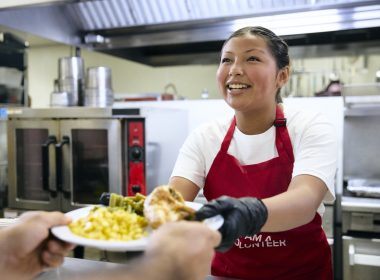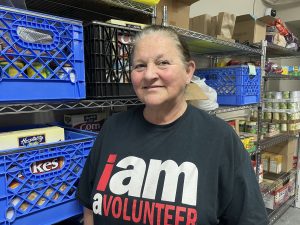Gary had one question on his mind when staff at the Broomfield, Colorado, Silvercrest Coordinator, came around.
“When are the kids coming?” he asked. “I’ve got a whole stack of pictures for them.”
The kids he’s referring to attend the elementary school across the street from the Silvercrest, one of 33 Salvation Army senior residences across the USA Western Territory.
On their school breaks, the students come by and deliver art projects to the seniors at the Silvercrest. And in some cases, the seniors reciprocate with their own craftsy creations. Gary cuts up calendars and makes special collages to share with the students. It’s something he and the other seniors eagerly await.
Programs like these allow Gary and other seniors at the Silvercrest to interact with people from other generations. And according to a wealth of research, it’s these very connections that allow both seniors and their younger counterparts to experience an increased sense of community, purpose and well-being.
“Unfortunately, many of our seniors don’t have family access anymore,” said Wendi Bishop, then coordinator for both the Denver and Broomfield Silvercrest properties. “The corps officers, the other residents in the building, the community—we become their family.”
Several studies have documented the impact of generativity, or investing in, caring for, and developing the next generation. One of them, the Harvard Study of Adult Development, began tracking more than 700 men in 1938 and continues to do so to this day. The most prevalent takeaway from the decades-long study: Relationships are the undeniable linchpin in well-being.
Harvard psychiatrist George Vaillant, who led that study for over three decades, wrote in his book Aging Well about the importance of spanning the generations. “In all three study cohorts, masters of generativity tripled the chances that the decade of the 70s would be for these men and women a time of joy and not of despair.”
That’s right—older adults who kept up meaningful connections with people from younger generations were three times as likely to be happy as those who did not.
It’s no wonder. When kids are young, they have adults around them, there to help them navigate life at every turn and show them how to engage with the world around them.
But as people move through adulthood, that dynamic begins to flip. Those in the younger generations, particularly children, grandchildren and neighbors, begin to care for the older adults who brought them up—and, in a way, help them navigate a world in constant flux.

As children, we need older, more mature people around us to share with us their sage wisdom and life experiences so that we might optimize our own life experiences. And as seniors, we need younger, vibrant individuals around us to help us stay active and engaged in our communities.
As Jo Stephanie Francisco, Silvercrest Management, said, we all need each other at every stage of life. That’s why there’s no quantifying the true impact of programs that provide meaningful connections on both ends.
“Intergenerational programs connect our senior residents to the community allowing young and old to learn about each other…which can enhance the outlook for both,” she said. “The seniors can provide their wisdom and knowledge. The young can provide up-to-date social and technological insights. It’s a mutual exchange of information. Our residents often request intergenerational programs because they love the exchange of ideas. The youth also love to hear about the seniors’ lives, their history and their experiences.”
It’s something with which Sarah Mixon is well-acquainted. As the coordinator of the 150-unit Eureka, California, Silvercrest Residences, she has an up-close view of how seniors and younger generations learn from each other and strengthen these intergenerational bonds.
“Up here in Eureka, especially since we’re really rural up here, our residents tend to be even more isolated than seniors in an urban area with more resources,” she said. “Fortunately, we have Cal Poly Humboldt up here.”
Just 10 minutes up Highway 101 from the Eureka Silvercrest is the northernmost campus of the 23-school California State University (CSU) system, nestled at the edge of a coastal redwood forest. The four year institution is home to just over 5,700 students, making it the second-smallest student body in the sprawling CSU network. But that makes for a tight-knit community.
The university’s Youth Educational Services (Y.E.S.) runs a series of student-led community engagement programs that provide opportunities for Humboldt students to volunteer in local school and community sites. One of those programs is a pen pal initiative between the student volunteers and the Silvercrest seniors.
“When we got the letters back from the students, I cannot tell you how amazing it was and how excited my residents were to know that they were receiving a letter and that they were writing back to college-age students,” she said. “And they could express their wisdom and their life experience. They were able to give real advice to adults who were a lot younger than them. It made them feel valued. Some of them were writing stuff like, ‘make sure not to ruin your credit!’”
The 33 apartment-style communities across the Western U.S. range in size from 22 to 257 units with private kitchens and comfortable living quarters to encourage independent living.
Once pandemic restrictions eased, Mixon scheduled a meet-and-greet for the pen pal program so the seniors and students could finally put a face to the handwriting.
She set up the Silvercrest’s community room, expecting the event would wrap up within an hour.
Yet, two-and-a-half hours later, the seniors and students were still there, swapping stories, deepening bonds they’d started forming months ago through the many letters they’d exchanged.
“Neither the residents nor the students wanted to leave,” Mixon said. “It was one of the most amazing things I’ve seen. And the beautiful thing about it was that the students came up to me afterward, and they told me how it touched their lives and how it brought back feelings of what it was like to talk to their grandma or grandpa. So they were really able to connect on a deep level. And some of the students told me they were surprised that they got so into it.”
That’s one of the secret benefits of such programs: particularly in western society, ageist ideas are far too ubiquitous. As a result, older people can feel neglected and become even more isolated. But with intergenerational programming, younger people can see with their own eyes how valuable and non-intimidating seniors really are.
Students help decorate the facilities for various holidays, local high school orchestra members came to play live “oldies Valentune” music on Valentine’s Day, and the young and old alike sing karaoke together on Fridays at the Silvercrest. Mixon even invited Gaining Ground, a local agency that works with developmentally disabled children and adults, to join in for karaoke.
“It’s a really awesome way of showing our younger generation that old people aren’t scary,” Mixon said. “They’re really cool, actually.”
Do Good:
- There is a place for you in The Salvation Army. See more in our annual print edition, “A Place of Belonging.”
- Start your day with goodness. Get on the list for Good Words from the Good Word and get a boost of inspiration in 1 minute a day with a daily affirmation from Scripture sent straight to your inbox. A pep-talk for the day. A boost of inspiration and comfort. A bit of encouragement when you need it. Get on the list and start receiving what you need today.
- You’ve probably seen the red kettles and thrift stores, and while we’re rightfully well known for both…The Salvation Army is so much more than red kettles and thrift stores. So who are we? What do we do? Where? Right this way for Salvation Army 101.












